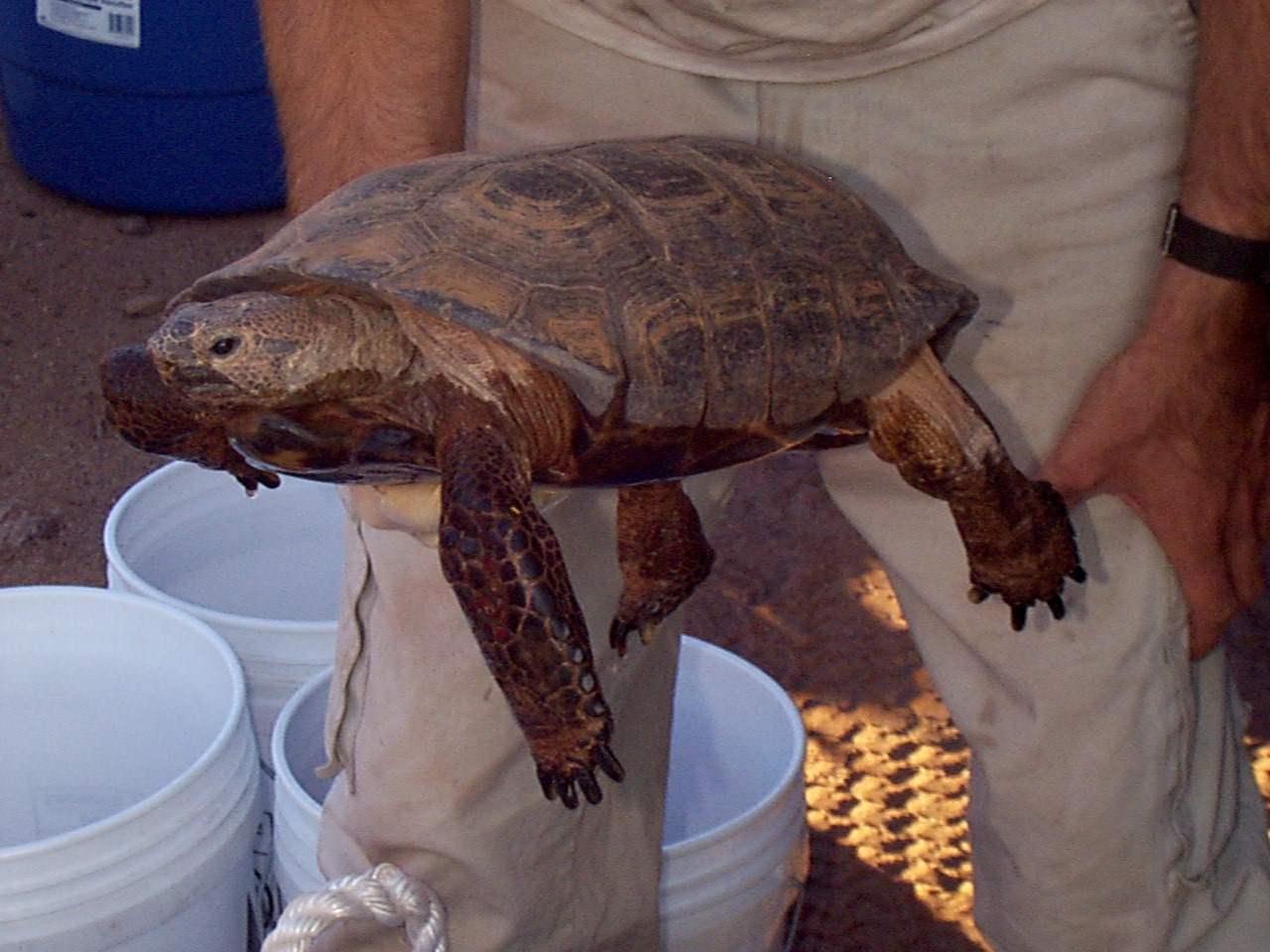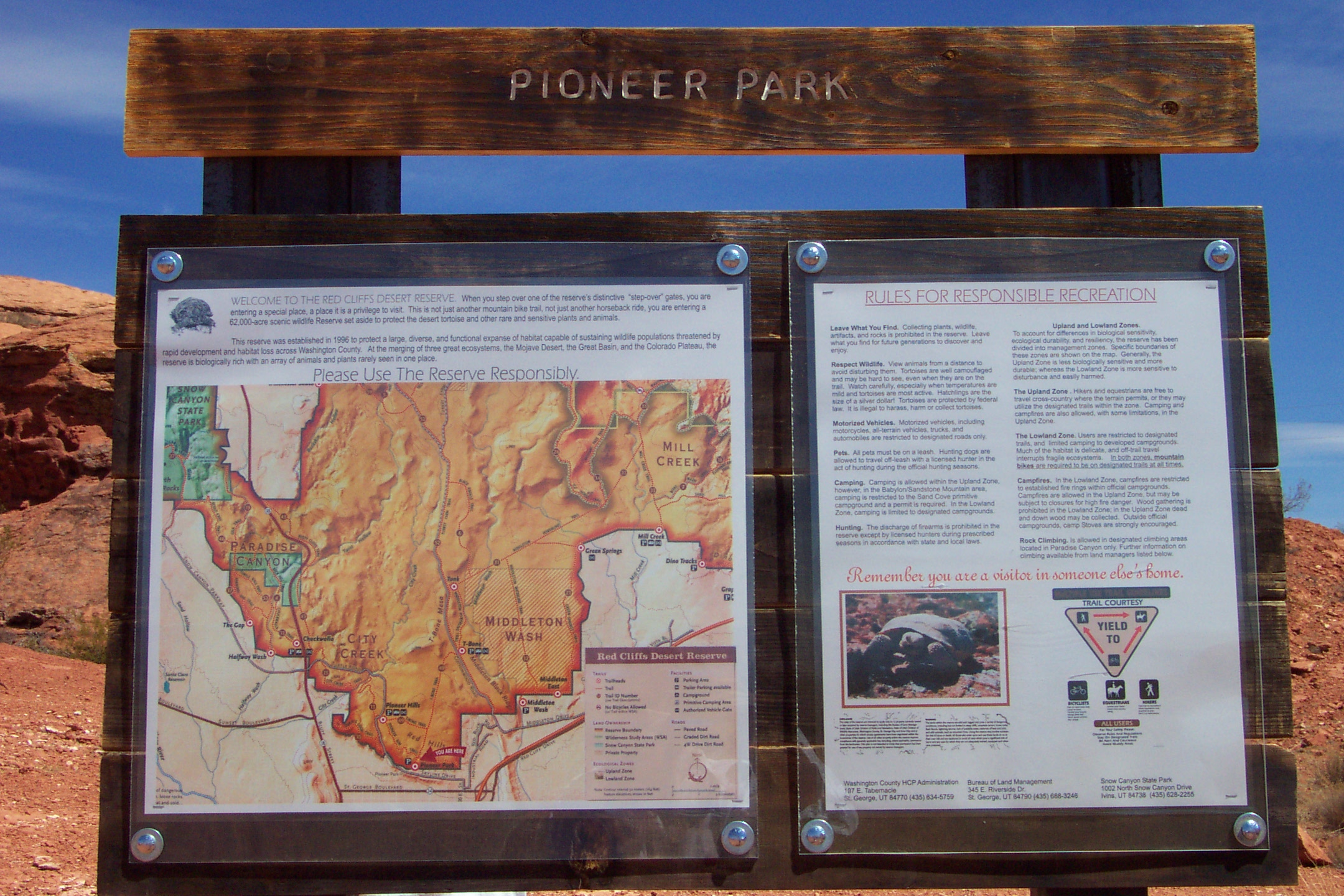Frequently Asked Questions
GEOCACHING MAY CONFLICT WITH HABITAT PROTECTION
Geocaching is an increasing popular activity similar to orienteering. Using a gps unit, a geocacher will look for caches hidden by others using global positioning coordinates. The cache is usually some type of weather-proof container, such as Tupperware, with trade items and a log book inside. Geocachers learn about caches and general cache locations on the website www.geocaching.com where they are posted. It is not unusual for people on vacation to get information on caches at their destination as a means to see the places most tourists would miss.
The placement of geocaches within the Red Cliffs Desert Reserve raises concerns for impacts to habitat caused by large numbers of people traveling off trail and the rapid development of “geo trails.” These impacts are not considered acceptable within the Lowland Zone where off-trail travel is not permitted by the Public Use Plan, and may even be a problem in the Upland Zone, depending on the placement of the cache.
To address these concerns, reserve managers are adopting the following policy to limit geocaches within the reserve:
1. All geocaches proposed to be located within the boundaries of the Red Cliffs Desert Reserve must have written approval from the Washington County HCP Administration prior to placement. Those located within Snow Canyon State Park must also have written permission from the park manager.
2. All geocaches within the reserve must include the following statement in the description of the cache:
This cache is located within the boundaries of the Red Cliffs Desert Reserve with the written permission of reserve managers. The Reserve is a 62,000-acre scenic desert area dedicated to the protection of the desert tortoise and other rare or sensitive species of wildlife. Non-motorized recreation is allowed within the lower elevations of the Reserve on designated trails only. If a trail is not marked with official reserve signs, it is not a designated trail. Cache seekers should visit www.redcliffsdesertreserve.com before entering the reserve to be sure that their activity is consistent with rules for responsible recreation that protect this fragile habitat area.
Thank you! Without habitat they have no home.
3. Geocaches placed without written approval will be removed.
4. Cache owners who placed geocaches before the implementation of this policy will be contacted. Geocaches in the Lowland Zone will be removed or relocated to an appropriate area. Geocaches within the Upland Zone may be allowed to remain if the location doesn’t create unacceptable impacts. The statement in Paragraph 2 above must be added to the cache description, or the cache will be removed. If the cache is permitted, a letter of authorization will be issued.
 YOU CAN’T TAKE THEM HOME,
YOU CAN’T TAKE THEM HOME,
BUT YOU CAN GIVE THEM A HAND
If you spot a desert tortoise or other desert animal in your neighborhood, first call the Red Cliffs Desert Reserve office at (435) 301-7430 . If you are unable to get assistance, call UDWR’s 24/7 Urban Wildlife Hotline at (435) 680-1461. If all else fails, local animal control officers can collect the animal and transfer it to the proper authorities.
What if you see a tortoise in the street? A common myth we hear from the public is that they believe they will get in trouble for moving a tortoise out of the road. Actually, wildlife officials encourage people to help a tortoise if it is in immediate danger of being hit by a car. Make sure you aren’t endangering yourself, then carefully pick up the tortoise and take him to the other side of the road in the direction that he is traveling. A common place to encounter tortoises is on Turtle Road (Red Hills Parkway). Be sure to set the tortoise down on the other side of the fence to keep him from wandering back into the road.
Remember, because they are a federally protected species, you cannot have a Mojave desert tortoise for a pet unless you have the necessary permits. Let them be wild.
Frequently Asked Questions about the Reserve
Q: What should I do if I see a tortoise in the road?
A: Make sure that you are not endangering yourself; if it is safe to do so, move the tortoise out of the road. Move it in the direction it was going. If there is a mesh fence along the road, put the tortoise on the other side of the fence.
Q: Won’t I get in trouble if I touch a tortoise? I thought there were big fines!
A: If a tortoise is in harms way, please move it. However, if the tortoise is not in danger, it is illegal to touch it.
Q: What if I find a tortoise outside of the reserve? Who do I call for more information?
A: If a tortoise is found in a developed area, please call (435) 301-7430 and reserve personnel will pick it up and relocate it to an appropriate area. Please do not attempt to relocate animals yourself. Sick tortoises can infect healthy tortoises with a deadly respiratory illness. The County tests each tortoise to make sure it is healthy before relocation.
Q: Are dogs required to be on a leash at all times while in the Reserve?
A: The answer is yes, dogs must be on a leash at all times within the Reserve.
Q: What is the difference between the Lowland Zone and Upland Zone?
A: In the Lowland Zone, hikers, mountain bikers and horses are required to stay on the designated trails. But in the Upland Zone off-trail use is allowed. The difference is in the topography and ecology of the Lowland Zone. The Lowland Zone is home to many threatened or endangered species of plants and wildlife. To see the delineation between the Lowland Zone and the Upland Zone, visit our trail maps webpage. Notice the difference between the green-shaded area and the brown-shaded area. The green-shaded area is the Upland Zone and the brown is the Lowland Zone.
Q: Is hunting allowed in the reserve?
A: Yes. Hunting within the reserve is permitted with a license for big game and upland game species during prescribed seasons throughout the Upland Zone, and within the Lowland Zone on the east side of Cottonwood Road, so long as it is consistent with city firearms ordinances.
Q: Can I target shoot?
A: No. The discharge of firearms is prohibited in the reserve except by licensed hunters in the act of hunting in accordance with state and local regulations.
Q: Is it true that tortoises are not native to this area?
A: While it is true that the local population of tortoises was augmented by the escape and release of captive pet tortoises brought to the area from Arizona and Nevada, tortoises are native to this area too. St. George and the surrounding communities are nestled in the northernmost extension of the Mojave Desert. Mojave species include the Joshua Tree, Creosote bush, Gila monster, sidewinder rattlesnake, and desert tortoise.
Q: What is the distinction between the Red Cliffs Desert Reserve, the Red Cliffs National Conservation Area (NCA) and the Washington County Habitat Conservation Plan (HCP)?
A: The HCP is a plan that was developed by local citizens after the desert tortoise and its habitat were protected under the Endangered Species Act (ESA). It took several years to develop a plan that everyone could agree to. The County submitted it to the U.S. Fish and Wildlife Service (USFWS) and it was approved in 1996. The 62,000 acres of habitat protected by the HCP for tortoises and other wildlife is called the Red Cliffs Desert Reserve. In 2009, approximately 45,000 acres of public lands in the Reserve were designated as the Red Cliffs National Conservation Area (NCA). These federal lands are managed by the St. George BLM field office.
 Q: How does the HCP benefit people and development needs in Washington County?
Q: How does the HCP benefit people and development needs in Washington County?
A: The plan allowed the issuance of a permit to the county from the USFWS which “unlocked” over 350,000 acres of desert tortoise habitat on private property outside the reserve so it could be developed. To date, thousands of acres from Ivins to Springdale have been developed as a result of the HCP, including shopping centers, hospitals, a freeway interchange and major residential and commercial areas. The HCP also stipulated that 1,169 tortoises could be “taken” or removed from these properties or accidentally killed as long as certain processes were followed.
Q: What would happen if there was no HCP?
A: There would be economic chaos because individual land owners in tortoise habitat would be required under the ESA to apply for their own individual HCP permit. This could cost each landowner many thousands of dollars in compliance fees and would require years for the USFWS to process. The Washington County HCP provides one “blanket” HCP that covers everybody so long as the individual city has signed an interlocal agreement with the County.
Q: Which cities have signed an interlocal agreement and are covered under the HCP?
A: Ivins, Santa Clara, St. George, Washington City, Hurricane, LaVerkin, Springdale and Toquerville. The unincorporated portions of Washington County are also covered.
Q: What happens if someone outside the above cities develops property in tortoise habitat?
A: They are required under federal law to consult directly with the USFWS to obtain their own permit or face significant fines.
Q: What happens to tortoises on property planned for development?
A: Before the property is developed, the developer coordinates with county staff, then county and state employees remove tortoises out of harm’s way at no cost.
Q: Who administers the HCP and how is it funded?
A: Washington County administers the permit and signed an agreement in 1996 to “Comply with and enforce the conditions of the permit”. The plan was restated and renewed in 2021. The county’s permit only authorizes tortoises to be displaced on private properties outside of the reserve. It does not exempt landowners from other applicable federal and state laws. Each participating city collects impact fees when development occurs; 2/10ths of one percent of new construction costs to build a house or commercial building.
Q: How long does the HCP permit last and what happens when it ends?
A: The renewed and reinstated permit that allows development to displace tortoises in participating cities will expire in 2046, unless it is renegotiated and extended at that time. If not, at that point it is uncertain who would administer the reserve– the county or a federal agency like the BLM. Regardless of who administers it, the reserve land will remain protected for wildlife, people and open space.
Q: What happens if a city decides to withdraw from the HCP?
A: The citizens of that city will have no protection for violations that will occur under the ESA.
Q: What happens to tortoises which are removed from developed areas?
A: They are blood tested to see if they are healthy. If they are healthy, they are released southeast of Leeds in an isolated part of the reserve north of the Virgin River. So far over 400 tortoises have been processed by the county to allow for development.
Q: What is a take area and where can I find more information?
A: A take area is a geographical area outside the Red Cliffs Desert Reserve designated as Mojave Desert tortoise habitat. Any development or habitat disturbance within a take area must be coordinated with the Desert Reserve administration. There are 10 take areas designated within Washington County. The maps of those 10 areas are available here.
To coordinate development, or if you have questions, please contact the Desert Reserve Administrator at (435) 301-7431 or the Habitat Biologist at (435) 301-7433.